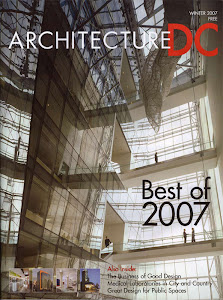 "You're going to be rich!", quips my friend, a mechanical engineer who is aware of the changes poised to take place in the Stadium-Armory section of Capitol Hill, as we discuss my home renovations. Though a nice notion, I think he might be a bit optimistic. Then again a little optimism can go a long way. That's how I usually feel when I look at the various development studies and master plans that are developed for target areas around the city. Projects such as the Anacostia Waterfront Initiative, H Street/Benning Road Transportation study (including those controversial, albeit attractive streetcars), and Poplar Point redevelopment appeal to our senses of what a city can be. I always get a rush of excitement when I look at the glossy renderings, especially viewed in contrast with images of what the areas look like today. I think that it is in our nature to want to see things made better (a quick glance at the TV Guide certainly attests to this fascination, with entire networks now devoted to improving home, health, and lifestyle).
"You're going to be rich!", quips my friend, a mechanical engineer who is aware of the changes poised to take place in the Stadium-Armory section of Capitol Hill, as we discuss my home renovations. Though a nice notion, I think he might be a bit optimistic. Then again a little optimism can go a long way. That's how I usually feel when I look at the various development studies and master plans that are developed for target areas around the city. Projects such as the Anacostia Waterfront Initiative, H Street/Benning Road Transportation study (including those controversial, albeit attractive streetcars), and Poplar Point redevelopment appeal to our senses of what a city can be. I always get a rush of excitement when I look at the glossy renderings, especially viewed in contrast with images of what the areas look like today. I think that it is in our nature to want to see things made better (a quick glance at the TV Guide certainly attests to this fascination, with entire networks now devoted to improving home, health, and lifestyle). The National Capital Planning Commission's RFK Stadium Site Redevelopment Study, released December 2006, is one of these types of proposals that can stir the imagination with visions of what might be. And it's a solid study, recommending the creation of greenspace in the form of a waterfront park with recreation facilities and a monument site, a commemorative facility, such as a museum or federal building, to match the scale of the adjacent Armory, and mixed-use development to provide residential and retail elements, such as cafes, restaurants, dry-cleaners, and bookshops. The study also recommends the realignment of the transportation network to establish Constitution and Independence Avenues as 'symmetrical key avenues' and reinforcing East Capitol Street as a grand avenue. Finally, there's also the clever notion to create a design element of the less than ideal, above-grade Metro line, such as Rem Koolhaas's rail station for the McCormick Tribune Campus at IIT.
The National Capital Planning Commission's RFK Stadium Site Redevelopment Study, released December 2006, is one of these types of proposals that can stir the imagination with visions of what might be. And it's a solid study, recommending the creation of greenspace in the form of a waterfront park with recreation facilities and a monument site, a commemorative facility, such as a museum or federal building, to match the scale of the adjacent Armory, and mixed-use development to provide residential and retail elements, such as cafes, restaurants, dry-cleaners, and bookshops. The study also recommends the realignment of the transportation network to establish Constitution and Independence Avenues as 'symmetrical key avenues' and reinforcing East Capitol Street as a grand avenue. Finally, there's also the clever notion to create a design element of the less than ideal, above-grade Metro line, such as Rem Koolhaas's rail station for the McCormick Tribune Campus at IIT.
Not surprisingly, the word 'Gateway' is used to define the area. Seemingly a catch-phrase of modern redevelopment, any project along what is considered a transportation corridor into the city is now dubbed a 'Gateway'. There's the Anacostia Gateway, the Northeast Gateway, the Georgia Avenue Gateway, and the winner for most titles, the South Capitol Street Gateway (aka the 'Monumental Gateway', aka the 'Gateway to the Future', and yes, even, the 'Green Gateway'). Because it is sited at the western base of the East Capitol Bridge at the edge of L'Enfant's historic plan for the City of Washington, the term gateway is applied here too (the 'Eastern Gateway' to be sure), though I question how fitting this is. And, despite it's alignment with the Capitol, L'Enfant actually paid little mind to this eastern most tip of E. Capitol Street, simply cutting off his grid of residential blocks just short of the river. If this is to truly be a gateway, then what will be the draw?
This is perhaps the greatest question raised by this study. If you build it, who will come? With Fenty's notion to retain the site for stadium use, at least there is the promise of civic use. As a nearby resident the notion of a waterfront park is, of course, appealing, and long overdue in our appreciation of the waterfront that the city has for too long neglected. And a waterfront park here could certainly create a significant tie to nearby Heritage and Kingman Islands. But I cast a look at underutilized Anacostia Park and wonder if waterfront parks alone are a real draw, or if they are simply a romantic notion. And while the study examines examples such as St. Louis's Jefferson National Expansion Memorial Park, with Eero Saarinen's iconic arch, and Paris's Le Champ de Mar, with its Eiffel Tower, the suggestion of a monument here is diminutive by comparison. The truth is that a monument of comparable scale would be inappropriate here, as it would compete with DC's signature Washington Monument. As such these comparisons may not be apt. I ask myself: Would Le Champ de Mar be the same without the Eiffel Tower?
If then landmark alone may not be enough to encourage the 'steady flow of visitors' discussed in the report, are there other legitimate notions to attract users here? While some of the images in the report suggest the potential for outdoor entertainment, this is not specifically identified in the text. But having an outdoor space for smaller scale live entertainment or perhaps even something like a DC Food, Wine, or Jazz Festival would be a novelty, (though of course concessions would need to be made by the National Park Service). Norfolk, VA's Town Point Park is a successful example of a waterfront park which successfully hosts these types of events annually.
Perhaps the more likely draw will be the commemorative facility, to be built opposite the Armory on East Capitol Street. Potential facilities mentioned include a museum, performance house, aquarium, or federal building. Like any study of this type, the specific use is left rather general, to be determined at a later date. Therefore implementation will be an important factor. But this aspect is one of the study's more well-conceived notions. The mixed-use component of the study certainly stands to benefit the community the most if plans to establish restaurants and service-oriented businesses are carried out. (Mind you this is coming from someone who is eager for the new Harris Teeter to open a metro stop away). But these are not swift moving projects. The Old Convention Center Site is an example of this, where the the process towards a new mixed-use development began in '05, yet the first buildings here won't be complete until 2011. So these things take time, and the whims of an ebb and flow housing market will undoubtedly have an affect as well.
The mixed-use component of the study certainly stands to benefit the community the most if plans to establish restaurants and service-oriented businesses are carried out. (Mind you this is coming from someone who is eager for the new Harris Teeter to open a metro stop away). But these are not swift moving projects. The Old Convention Center Site is an example of this, where the the process towards a new mixed-use development began in '05, yet the first buildings here won't be complete until 2011. So these things take time, and the whims of an ebb and flow housing market will undoubtedly have an affect as well.
From my vantage, there is much reason to focus efforts on this area beyond the obvious 'the stadium may soon be empty' reasoning. At a time that the housing market is on a downswing, the location is attractive to home-buyers looking for an affordable residential neighborhood that has single-family housing options and is decidedly less dicey than other emerging parts of the city. Well served by public transportation, including metro, and walking distance to nearby Lincoln Park and Eastern Market, the neighborhood comes alive on sunny weekends. And I am optimistic that the redevelopment of this area might further benefit existing community resources such as neighboring schools.
As I mentioned in Part One, there are several ways in which the groundwork of the NCPC study might be combined with a potential new sports complex, should efforts to get the Redskins to return to the District pan out. I'm hopeful that, should that endeavor succeed, aspects of the NCPC study will be implemented.
It will certainly be some time before any actions are taken towards the realization of a redeveloped site. My only hope is that the stakeholders in this project are ready to act once the last game is played and the lights go out on RFK.
Thursday, April 10, 2008
Considering the Future of Stadium-Armory -- Part Two: DC's Own Le Champ de Mar?
Labels:
National Park Service,
RFK,
Waterfront Redevelopment
Subscribe to:
Post Comments (Atom)









No comments:
Post a Comment